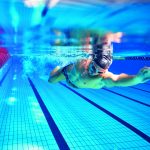From the pool to open waters: acknowledge your weaknesses and overcome them!
Let’s look at some potential weaknesses of people used to swimming in a pool and try to offer some tips for tackling open-water swimming as best possible.
Adapting to new circumstances takes time, as well as a very subjective kind of predisposition. I mention adaptation and subjectivity, because the transition from a pool to open waters can be tricky, particularly for those so used to following the blue line along the bottom of the pool.
In this article we will look at some potential weaknesses of people used to swimming in a pool and try to offer some tips for tackling open-water swimming as best possible.
SCENARIO 1: excellent performance in the pool but terrible in open waters.
You probably have two problems: not used to the sighting issues associated with open-water swimming and a fear of what might be beneath you in the water. In the first instance, you are likely to swim further than necessary and, consequently, take longer to get from A to B; in the second case, fear might impact negatively on your swim stroke and slow you down in races.
- TIP: the best way to overcome your fears if they are really affecting your performance is to face up to them or, if you cannot do that on your own, find a Mental Coach to help you out. Otherwise you can try and find strategies that can be applied in the pool, like, for example, swimming with your eyes closed over short distances focusing on controlling your swim technique.
There are various ways of learning the art of sighting in a pool. The first is to swim with your head raised for a few yards after pushing off the edge of the pool, focusing on a chosen starting block and then swimming normally again. If you can, you could try removing the lane ropes and using floats to simulate the directional buoys in races.
SCENARIO 2: poor technique.
This might be a real limiter if you are not getting the results you would expect from all the hard work you are doing in the water. If this is this case, swimming is likely to become frustrating not just in the pool but also in open water.
- TIP: Step one, find out what is wrong. Is your swim stroke inefficient? Are you using your legs properly? Is there an issue with your position in the water? It is vitally important to work on your weakness and not shy away from it.
- Step two, find a coach to train you. Unless you are extremely aware of what you are doing in the water, it will be hard for you to correct any mistakes you are making without somebody’s help. A professional expert will be able to tell you what you are doing wrong and correct it. Sometimes it really does only take a few useful tips.
- Step three, practice correcting your mistakes. Focus solely on technique for ten minutes at the beginning of every training session.
SCENARIO 3: you only have “one gear”.
A very important trait of an open water swimmer is the ability to change pace when required. At the beginning of a race to break free from the group and any potential contact or mishaps; when accelerating after rounding a buoy; and in the final sprint when everybody is really tired.
- TIP: learn how to vary your training. The fact you are training for long distances does not necessarily mean you should not include 25 m or 50 m flat-out sprints in your training sessions. On the contrary, this kind of training will help you, on both a biomechanical and neuromuscular level, to have a faster arm turnover and also teach you how to change pace. So, learn how to swim at different places and do not train at the same speed all the time.
Enjoy your training!
Written by:
arena coaches
Swim coaches, trainers and experts will give you all kinds of tips for performing at your best in both training and races.







